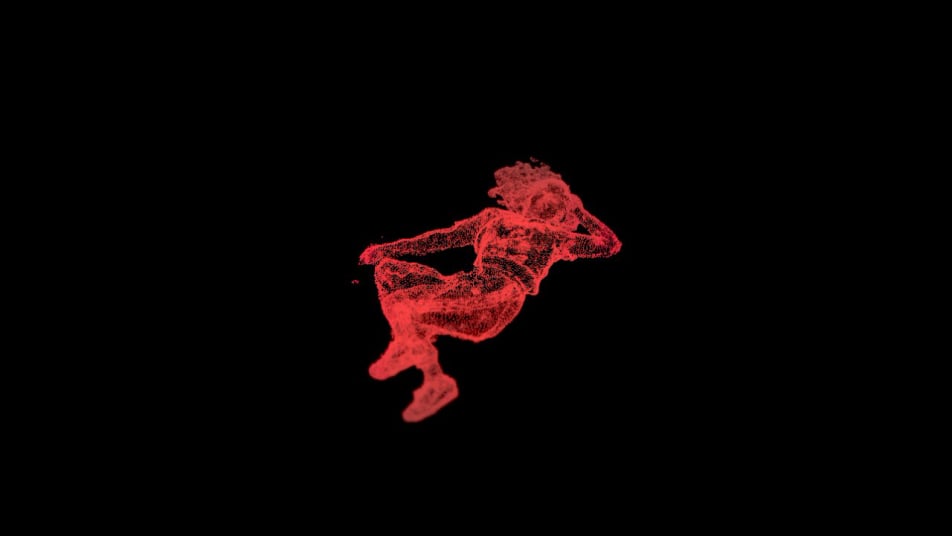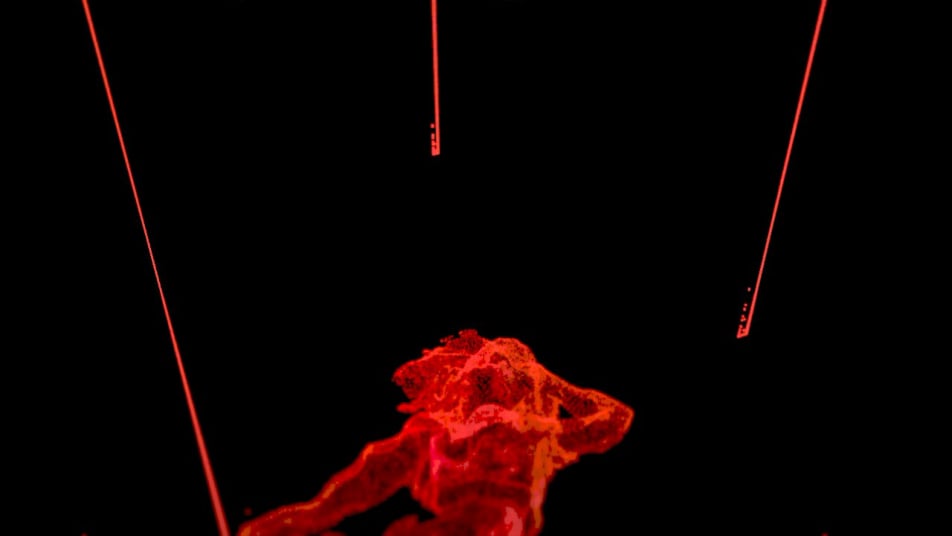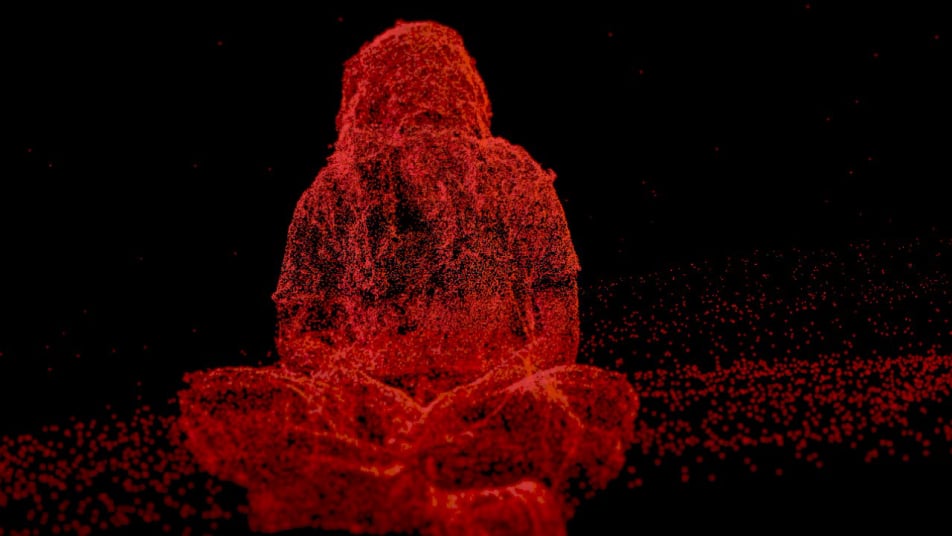
In the video, we first start with a point cloud model in which the protagonist is laying down, and we slowly move the camera around her.
This prototype relates to the third and final act of the story. This is the climax of the story, in which the protagonist has lost all will to live and is planning to overdose herself. You can find a excerpt of the story below:
I am lying beneath my window in my room, the twilight tints everything inside in a cold, bleak hue and an even colder gush of air surges above my head.
My hands are shaking, my heart is racing and my vision is blurred from the tears. Thin blood runs down my body as I continuously charge the needle into my arms but either I pierce through my vein or I slip out, and I have to pick up the syringe from the puddle of blood that has slowly formed around me.
As the last ray of sunlight vanishes and my room is completely clouded in shadows, I finally hit the vein, I see blood flowing upwards into the pump and I push down the entire load into me.
At first, my mind is still a whirlwind of thoughts gradually, as I surrender to the weightlessness of my pillow, the world around me begins to fade. The distant sounds of traffic outside become distant echoes, and the soft glow of streetlights filters through my curtains like distant stars.
With each rhythmic breath, I drift further away from reality, like a boat gently pulled by the currents of a calm sea. The boundaries of consciousness blur, and the tangible world dissolves into a realm shrouded in suffocating darkness that seemed to devour all light.
The boundaries of my physical form dissolve, and I become a mere observer, floating in the vastness of my subconscious. I was overcome by a surreal sense of detachment, as though I was observing myself from afar. The sounds around me faded into an eerie silence, and a feeling of weightlessness enveloped me.
My sister found me later that night, unconscious, without a pulse, and blue. When I woke up, I had been told I was in an ambulance on my way to hospital, and I had overdosed on Heroin. I was 24 at the time. I remember the paramedic saying to me, “Come on, Elliot. Stay with us. You’re too young”. I was too young. Too young to have experienced so much pain.
I approached this prototype with two goals in mind: first, I wanted to create a similar ambience to the one that Disasterpiece uses in his tracks and second, I wanted to learn how to work with point clouds in TouchDesigner.
In one of my earlier prototypes, I used the track “Vignette: Panacea” of DisasterPeace, which you can see below. Here I twist the shape of a torus on the X and Y axis based on the low and high frequencies of the song respectively.
Sound Design
The atmosphere of this song really struck a chord in me and I found something like this would be perfect for the last act. As such, I set out to learn how to create a track like this myself.
Based on some tutorials on Youtube (e.g. this one ) and a workshop from the man himself, I created my own patch in Vital. If you want to create a similar sound, here are some details.
Let’s talk first about the sound design:
For the envelope of the patch we want a long attack, relatively short decay and sustain, and long release. Regarding effects, we can play with chorus, reverb and delay. In addition, Disasterpeace uses a lot of bitcrusher effects to create this analog warmth feeling, similar to Lorn! Fun fact, the pad I created here, I also used in “A whole new world” where I tried to emulate Lorn’s sound. Lastly, to make the sound of the pad feel more dynamic and alive, I added some random panning and noise and mapped the chorus, reverb and bitcrusher effects to the modulation wheel of my MIDI keyboard.
Next, let’s talk a bit about music theory:
Disasterpeace generally avoids tonic chords, instead he uses very big, spread out chords that include various color notes like 7s, 9s etc.. In addition, he uses a lot of bitonality, that is playing in two keys at the same time. For instance, he would play bass notes that are completely different from the key of the right hand chord, e.g. C2 / Ab to Eb2 / F to C2 / Db. This combined with the sound design mentioned above creates a very cool atmosphere, because we never really resolve and get back to a tonic.
With the music theory in hand and a self-made pad in Vital, I then started to simply improvise over some (bitonal) chords and came up with a nice chord structure that also includes some key changes.
At the end of the track, I make use of the pitch wheel to bend up all the notes and I add a lot of reverb and distortion, to simulate the soul leaving the body of the protagonist when she overdoses. In post, I duplicated the recording and panned it left and right, to give more space for the voice acting. Additionally, I also added some more of that sweet saturation for extra analog warmth, and added a sub bass, following the bass note of the chords.
Later, I recorded the voice acting and slightly adjusted my improvised recording that I made in the beginning. The voice recording was done in my little home studio and there were some cars passing by the street that you can slightly hear in the background of the recording. Later, it also started to rain, which was also audible in the recording. I tried gating the recording (cutting out the background noise when she is not speaking) but it was very hard to filter out all the background sounds. That said, I found that these sounds added more to the ambience and just removed the low end from the recording and made a little bit more space in the frequency band for the voice actor. Combined with the lush sounds of the pads, this creates a nice, dark ambience.
Visuals
One of my goals for this prototype was to learn more about using point clouds in TouchDesigner. During my research I found this video, and tried to create something similar.
To create the point cloud itself I used Polycam. I asked one of my friends to model for me in various positions and took a series of images with Polycam. The app then combines all these images into a 3D model which can then be downloaded and inserted in TouchDesigner.
Once I loaded the models into TouchDesigner and created a render setup to display the models, I first experimented with adding some random noise to the position of the points to make the point cloud feel more alive, and animating the camera movement around the model. Additionally, I also added some blur to the top and bottom of the render, to give it more depth. Then I experimented with more advanced manipulations of the point cloud, like the ones used in this video.
You can see an early prototype here. At this point I didn’t have the voice recording yet, so the music is a lot louder than in the final version.
Once I had the soundtrack and the voice recording done, I started to combine everything together!

In the video, we first start with a point cloud model in which the protagonist is laying down, and we slowly move the camera around her.

When the protagonist talks about the blood running from the veins, two things are happening:
You can see three “streams of blood” coming down from the top of the screen. These lines are actually just smaller versions of the same point cloud model, where I create a feedback loop in which I translate the Y position of the individual points downwards.
The second thing that is happening is that I slowly apply more and more noise to the main point cloud model, which makes it look more and more liquid until it resembles the “puddle of blood” that is mentioned by the protagonist.

We then zoom into the model and the mind of our protagonist when shit hits the vein. Additionally, I also stretch out the previous model to make more space for the 2nd model and to create some ambience around her.
Finally, the protagonist describes how she is losing her conscience. Here, we pitch up the music and we also let the points float up to symbolize the soul leaving her body.
I think this is the prototype I am the least happy with.
I really liked the first version I made without the voice recording because the music is way louder in the mix, and the sound design really gets to shine, however when I add the voice, I have to make the music a lot quieter so you can actually hear the voice. Additionally, I find that the mixing is generally a bit off in the 2nd version, as the vocals and the pads sound very detached. Generally, I found it hard to mix the reverb such that I create the illusion that the voice is in the same room as the rest of the sound.
Additionally, I like the camera movements and overall presentation of the point cloud better in the first version, however there was still a mistake in animating the noise at the end of the video.
Next to the camera movements and mixing of the sound, I would have liked the “blood streams” to be more dynamic, e.g. by adding additional noise to make it more liquid-ish and adding some kind of acceleration effect. I also would have liked to make this piece more audio reactive by for instance syncing the period of the color changes to swell of the pads.
Sadly there was not enough time left for me to really finalize this piece, but that’s ok since this is a research project :)
AI Website Software